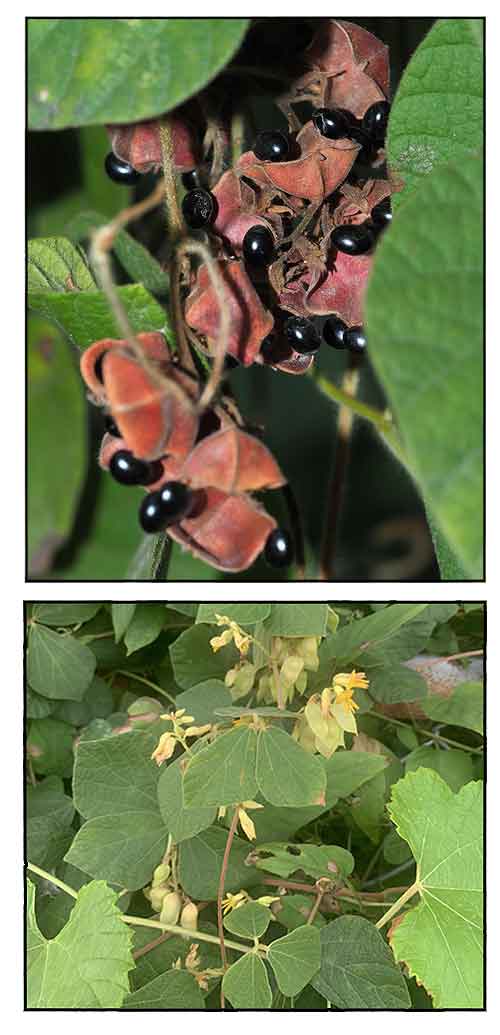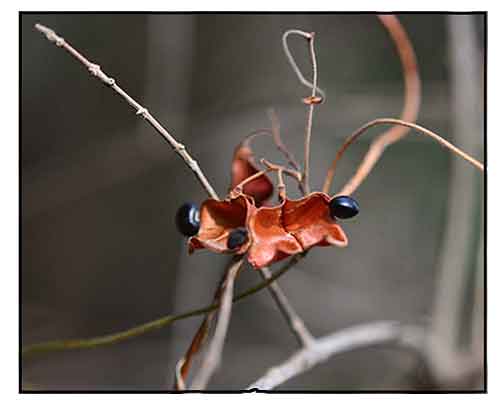 Gen info Gen info
- Rhynchosia genus consists of approximately 300 species circulated throughout the tropical and subtropical areas of the world, with 22 species occurring in India.
- The genus Rhynchosia Lour. was first introduced by Loureiro to accommodate the species Rhynchosia volubilis Lour.
- Etymology: The genus name Rhynchosia derives from the Greek word rhynchos, meaning a beak, snout, or horn, referring to the shape of the keel petals. (12) The specific epithet volubilis derives from Latin meaning "twining or vining", referring to the plant's growth habit.
Botany
• Herbs. Stems twining, ribbed, densely gray to light yellow villous. Leaves pinnately or sometimes almost digitately 3-foliolate; stipules small, lanceolate, 3-5 mm, pubescent; petiole 2-5.5 cm; petiolules 2-4 mm; leaflets papery; terminal leaflet rhomboid or obovate-rhomboid, 3-8 × 3-5.5 cm, both surfaces gray or light yellow villous, with yellow-brown sessile glands, basal veins 3, base rounded or broadly cuneate, apex obtuse or acute, usually mucronate; lateral leaflets smaller, usually oblique. Racemes 1-3 per axil, 1.5-4 cm; peduncle ca. 2 mm. Flowers ca. 1 cm, slightly clustered. Calyx campanulate, ca. 5 mm; lobes lanceolate, exterior pubescent and with glands. Corolla yellow; standard subcircular, with wide and inflexed auricles; wings obovate-oblong, base with 1 long auricle at one side; keels beaked. Ovary hairy, with clustered glands. Legume reddish purple, oblong, 1-1.5 × ca. 0.8 cm, extremely compressed, slightly constricted between seeds, sparsely hairy to almost glabrous, apex with small beak. Seeds usually 2, black, lustrous, elliptic or subreniform. (Flora of China)
Distribution
- Cultivated, not naturalized.
- In Benguet, Mountain Province; in open grasslands, 1400-2000 m.
(1)
- Native to China Southeast, Hainan, Japan, Korea, Nansei-shoto, Taiwan, Vietnam. (2)
Constituents
- Bioactive-guided fractionation of MeOH extract of seeds isolated galllic acid methylester (1), gallic acid (2), 7-O-galloyl-catechin (3), 1,6-di-O-galloylglucose (4), 1-O-galloylglucose (5), and trigalloylgallic acid (6).
(see study below) (9)
- Phytochemical screening showed presence of alkaloids, amino acid, carbohydrate, flavonoid, glycoside, phenolic compound, saponin, starch, steroid, tannin, polyphenol and protein, with absence of reducing sugar and terpenoid. (13)
-
Nutrient analysis of powdered leaves yielded protein 14.09%, fiber 21.04%, fat 3.73%, ash 11.18%, moisture 10.02%. Elemental analysis of powdered leaves yielded (mg/L) calcium 72.94. manganese 0.835
, lead -3.593, chromium -0.803, cadmium 0.047, zinc 0.038, copper 0.026. (13)
Properties
- Plant considered antimicrobial, contraceptive, depurative, diuretic.
-
Studies have suggest antihyperlipidemic, anti-apoptotic, shelf-life extending, antioxidant , spermicidal , dry-eye relieving, estrogenic, antioxidant, antithrombotic, cytotoxicity properties.
Parts used
Seeds, leaves, whole herb.
 Uses Uses
Edibility
- Seeds are edible; cooked.
- Seeds, up to 30% weight are incorporated into soya beans (Glycine max) for making tofu. (see study below: 7)
Folkloric
- No reported folkloric medicinal use in the Philippines, (2)
- In China, a folk prescription for contraception.
(8)
- Cosmetic formulations used by Koreans for depigmenting of skin stains, treatment of skin wrinkings, and anti-aging. (4)
- Used for treatment of kidney disease, neuralgia, postmenopausal osteoporosis, and senile dementia.
- Seeds used for treatment of abdominal pain in women; headaches, poisoning, and scrofulous glands. Plant used for treatment of intestinal inflammation. (3)
- In Japanese folk medicine, seeds used as expectorant. In Myanmar, infusion of leaves used to relieve dropsy, edema, and hydropis. Dried leaves preparations used for blood clearing. (13)
- In traditional Chinese medicine, used to
increase urination, eliminate swelling, activate blood, and detoxify.
Studies
• Effect on Cell Survival: Study evaluated the effect of ethanol extract from R. volubilis (EERV) on HeLa cell survival and to elucidate its biochemical signaling mechanisms. Results suggest the EERV protects against apoptosis by activating cell survival pathway through the cAMP-PKA/ERK-CREB pathway. (5)
• Niga-Ichigoside Fe / Antihyperlipidemic / Antioxidant: Research reports on Niga-ichigoside F1, an orally active ursane triterpenoid from Rhynchosia volubilis that has antihyperlipidemic and antioxidant activity. Niga-ichigoside F1 can prevent high-fat diet (HFC)-induced hepatic steatosis. (6)
• Effect on Texture and Storage of Tofu Incorporated with R. volubilis: Study evaluated the effects of R. volubilis (yakong) incorporation (0, 10, 20, and 30% w/w of soybeans) and quality and shelf-life of tofu. Results showed slight increase in moisture content of tofu in 20 and 30% samples. Different levels of yakong incorporation showed significant influence (p<0.05) on color characteristics of tofu. Texture varied with level of yakong incorporation; however, with so significant difference (p>0.05) in most cases. Incorporation showed a shelf life at least 1 day longer than control tofu. (7)
• Potent Spermicidal: In China, the plant is a folk prescription for contraception. Study have reported the antifertility effects on male mice and antimicrobial activities on sexually transmitted infection (STI). Study evaluated the n-butanol extract of RvLour (BERVL) as spermicidal agent with STI preventive effects. Spermicidal activities were assessed using selected high-motile sperms of normal human semen samples, and their inhibitory effects of Lactobacillus acidophilus. Results showed dose-dependent spermicidal activity and inhibitory effects of BERVL on Lactobacillus acidophilus. A 90 mg/mL dose terminated all progressive sperm motility within 2 mins, and showed slight inhibitory effect of L. acidophilus, suggesting an effective and safe dose for contraception use. About 80% of sperms exposed to BERVL showed changes consistent with high permeability of head membrane. Results suggest BERVL as spermicide with advantages over N-9, strong ability to instantaneously kill human sperm, with light inhibitory effect on L. acidophilus. (8)
• Antiproliferative Against Human Cancer Cell Lines / Seeds: A MeOH extract of seeds showed antiproliferative activity against human gastric adenocarcinoma (MK1, 50% growth inhibition: GI50] at 25 mcg/ml), human uterus carcinoma (HeLa, GI50 30 mcg/ml), and murine melanoma (B16F10, GI50 of 8 mcg/ml) cells. Bioactive-guided fractionation isolated gallic acid methylester (1), gallic acid (2), 7-O-galloyl-catechin (3), 1,6-di-O-galloylglucose (4), 1-O-galloylglucose (5), and trigalloylgallic acid (6). Tested for antiproliferative activity, all showed much stronger inhibition against B16F10 cell growth than against HeLa and MK-1 cell growth. (9)
• Protective Against Dry Eye Disease: Study evaluated the protective effect on the cornea of a standardized ethanol extract of R. volubilis (EERV) in benzalkonium chloride (BAC 0.2%)-induced mouse dry eye model. Control group was treated with commercial eye drops. EERV treatment significantly improved fluorescein scoring, BUT, and smoothness in the cornea compared to control. EERV also inhibited squamous metaplasia and apoptosis in the cornea. EERV treatment inhibited expression of cytochrome c and BAX, and improved Bcl-2. Results suggest standardized EERV has potential for the treatment of dry eye disease. (10)
• Physiological Regulation of Cation Channel of Sperm / Whole Herb: Study evaluated the effect of compounds from R. volubilis on physiological regulation of cation channel of sperm. Bioguided study isolated five new prenylated isoflavonoids, rhynchones A-E (1-5), a new natural product, 5'-O-methylphaseo-linisoflavan (6), together with 12 known compounds (7-18). Experiments of intracellular Ca2+ signals and patch clamping showed rhynchone A (1) significantly reduced cation channel sperm activation by competing with progesterone. Study suggests rhynchone A may act as a contraceptive compound by impairing the activation of cation channel sperm and preventing preventing fertilization. (11)
• Comparative Effect on MG-63 Human Osteoblastic Cell Proliferation and Estrogenicity / Seeds: Seeds of R. volubilis (SRV) and soybean (SB) have been used in oriental folk medicine to prevent post-
menopausal osteoporosis. The beneficial effects are attributed to high isoflavone content that functions as partial agonists or antagonists to estrogen. Study compared the effects of SRV and SB on MG-63 osteoblastic cell proliferation using 70% ME of SRV and SB treated on MG-63 cells. Results showed both SRV and SB extracts increased MG-63 cell proliferation, with SRV showing more effective increase in cell proliferation that paralleled with greater estrogenic effects. SRV-induced IGF-1 expression resulted from increase in mRNA levels. The greater estrogenicity of SRV for MG-63 cell proliferation is mediated by synergism of low levels of isoflavones for selective expression of IGF-I. (12)
• Antioxidant / Cytotoxicity / Antithrombotic / Soybean Peptide Mixture: Study evaluated the antioxidant ability of a novel peptide mixture purified from black soybean (Rhynchosia volubilis) that exhibited antioxidant ability (IC50 119.8 µg/ml) using in vitro ABTS assay. Confirmatory testing evaluated the antioxidant ability of the peptide mixture using cell culture systems. The black soybean peptide (BSP) significantly reduced H2O2-induced cell death in C2C12 myocyte. and activated extracellular signal-regulated kinase (ERK) signaling. Assessing antithrombotic ability of BSP in a rat model, BSP exerted antithrombotic effects in rat blood. Results suggest the BSP purified mixture exerts inhibitory effect on both oxidative stress and thrombosis. (14)
• Amelioration of Gut Microbial in Ovariectomized Mice / Potential as Functional Food: Study evaluated the in vivo effect of small black bean (R. volubilis) on ovariectomized mice and its impact on intestinal microbiota and metabolic status. Ovariectomized mice exhibited significant body weight gain, typical postmenopausal symptoms, and microbial changes. Administration of extract restores body weight and gut microbial perturbation to normal levels. Results suggest small black bean extract is a potential candidate as functional food for treating postmenopausal symptoms via remodeling of intestinal microbiome. (17)
Availability
- Wild-crafted.
- Seeds in the cybermarket.
|

![]()




